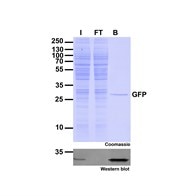Which beads should I use for my immunoprecipitation?
In detail, all beads have very low background binding due to the highly specific binding of the Nano-Traps.
ChromoTek's Nano-Traps are optimized for the immunoprecipitation (IP) of proteins and their interacting factors. Nano-Traps comprise of a Nanobody/ VHH conjugated to beads. For 5 Nano-Traps, e.g. GFP-Trap®, Halo-Trap, RFP-Trap®, Spot-Trap®, and V5-Trap® we offer different types of beads:
- Agarose beads
- Magnetic Agarose beads
- Magnetic Particles M-270
Based on the properties of the different beads (see table), we recommend:
- Agarose beads for very low background and high binding capacity IP
- Magnetic Agarose beads for magnetic separation and high binding capacity IP
- Magnetic Particles M-270 for IP of very large proteins/complexes

Immunoprecipitation with GFP-Trap.
I: Input, FT: Flow-Through, B: Bound
|
|
Agarose |
Magnetic Agarose |
Magnetic Particles M-270 |
|
Low background* |
+++ |
++ |
++ |
|
Binding capacity |
+++ |
+++ |
+ |
|
Size of tagged protein* |
Small to large |
Small to large |
Small to very large |
|
Bead separation |
centrifugation |
magnetic |
magnetic |
*Please note that these are general guidelines. For a specific protein or complex, the optimal experimental conditions have to be tested.
In detail, all beads have very low background binding due to the highly specific binding of the Nano-Traps. In comparison, Agarose beads have the lowest background. The background of Magnetic Agarose beads and Magnetic Particles M-270 is at slightly higher. Hence, Agarose is recommended if a very low background is needed.
For automated immunoprecipitation or when magnetic handling is preferred in general, Magnetic Agarose or Magnetic Particles M-270 shall be used. However, Magnetic Agarose is recommended if a higher binding capacity is required.
The size and shape of your protein of interest (POI) may require the use of the non-porous Magnetic Particles M-270, because larger proteins or protein complexes can’t access the Nanobodies/ VHHs inside the pores of agarose and magnetic agarose beads. Note that smaller proteins may form multimers or may be part of larger complexes and hence have larger sizes than expected.
|
|
Beads |
||
|
|
Agarose |
Magnetic Agarose |
Magnetic Particles M-270 |
|
Matrix |
Agarose |
Magnetic agarose |
Magnetic Particles M-270 |
|
Bead form |
Porous |
Porous; sold iron core |
Solid |
|
Ligand |
Nanobody/ VHH |
Nanobody/ VHH |
Nanobody/ VHH |
|
Protein size* |
Small to large size |
Small to large size |
Small to very large size; all sizes |
|
Color |
White |
Black |
Brown |
|
Medium particle size |
~90 µm |
~40 µm |
2.8 µm |
|
Binding capacity |
Very high |
Very high |
Medium |
|
Background |
Very low |
Low |
Low |
|
Magnetic separation & automation |
no |
Yes |
Yes |
|
May be centrifuged up to |
2,500 x g |
800 x g |
8,000 x g |
* Does depend on protein size and shape, protein multimers, complexes, and interaction partners
GFP-Trap Agarose
GFP-Trap Magnetic Agarose
GFP-Trap Magnetic Particles M-270
Halo-Trap Agarose
Halo-Trap Magnetic Agarose
Halo-Trap Magnetic Particles M-270
RFP-Trap Agarose
RFP-Trap Magnetic Agarose
RFP-Trap Magnetic Particles M-270
Spot-Trap Agarose
Spot-Trap Magnetic Agarose
Spot-Trap Magnetic Particles M-270
V5-Trap Agarose
V5-Trap Magnetic Agarose
V5-Trap Magnetic Particles M-270
